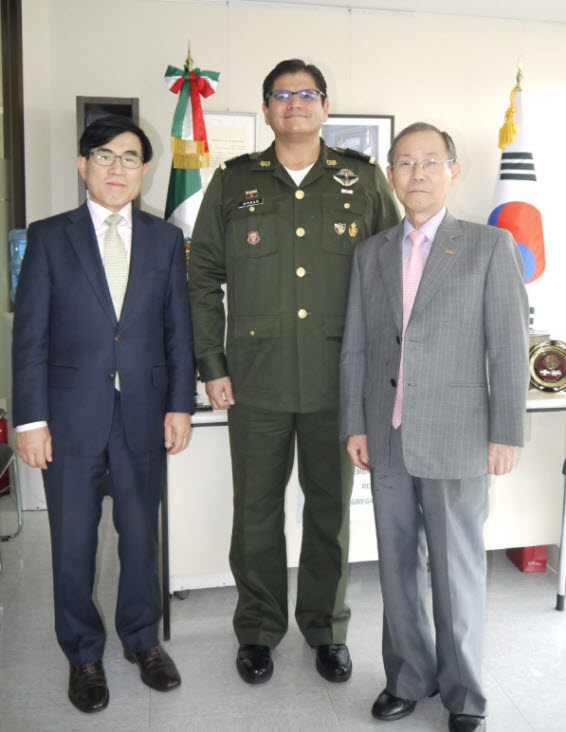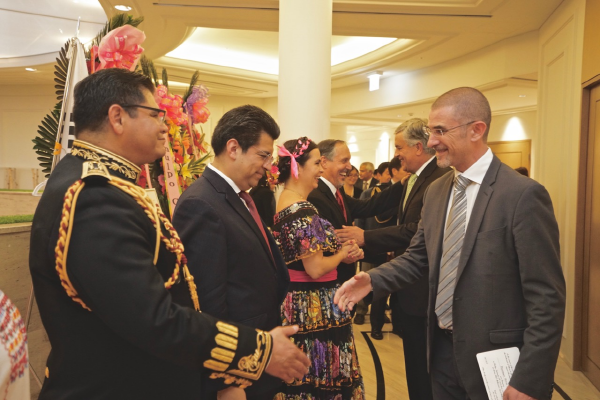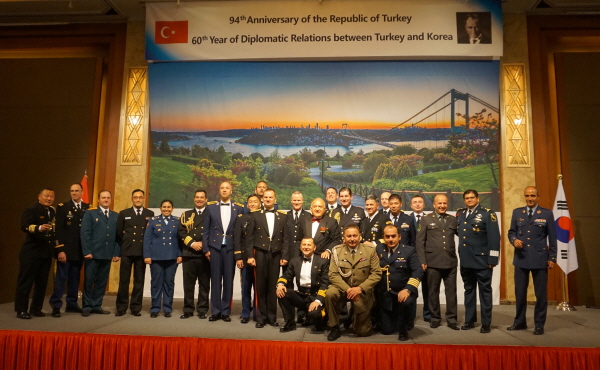Interview with The Korea Post media for Korean, international audiences
By The Korea Post Reporters Ms. Kim Sua and John Kim
It appears that the defense attaches at the different embassies in Korea are now in good hands. This would also greatly contribute to further promotion of relations and cooperation between the Korean government defense and military authorities and the defense-military attaches of the different embassies in Seoul.

“The Dean of the Seoul Association of Military Attaches (SAMA) is on a voluntary basis and a number of candidates, including myself, expressed their willingness to serve the Corps as its leader,” said Brigadier General Hector Francis Moran Gonzales of Mexico in Seoul at a recent interview with The Korea Post, publisher of 3 English and 2 Korean-language news media.
The SAMA may have a distinct advantage over the Seoul Diplomatic Corps (SDC), organization of the ambassadors, because as it is on a voluntary basis in contrast with the SDC where the dean is selected seemingly unconditionally on the basis of the order of seniority of accreditation to Korea regardless of difference in the degree of interest on the part of the dean in the job or the welfare of the members and the readiness to serve the interest of the members of the Association.
In fact, Brig. General Gonzalez has been the first dean of the SAMA in Seoul who has agreed to an interview proposed by The Korea Post media in its 32-year history.
The Korea Post media, established in 1965, are managed by the Publisher, who is the former Weekly Columnist and Cultural Editor of The Korea Herald (Korea’s leading English daily) and winner of the Korean Literature Award of The Korea Times (another leading English daily in Korea).
In this regard, Brig. Gen. Gonzales of Mexico might be considered the best selection among the members of the SAMA. Leading an organization comes as an extra work burden on the leader, and the best leader, perhaps, is one who is willing to bear the extra work burden for the benefit of its members.
There is one thing about the contribution of the Mexican-descent military personnel of the United States Army made during the Korean War (1950-3), where they fully exhibited their gallantry and greatly contributed to the defense of freedom and democracy in Korea. (Further details after the end of the interview article.)
In this regard, members of the SAMA may merit a due applause for their wise selection. Excerpts from the questions and answers at the interview follow:

Question: What are the activities of the Seoul Association of Military Attaches and how is the leader chosen?
Answer: We, the defense attaches in the Republic of Korea, what is called, ‘The Seoul Association of Military Attaches,’ formed with the members of the defense attaches of all the embassies in Seoul. They select their leader on a voluntary basis through free voting.
I was selected through such an election process. I am told that I am the first Latin American military attaché to be elected Dean of the SAMA, and I consider the election a great honor and I will do my best to do my job properly to fully meet the expectations of the members.
I hope that I can fully serve to the cause of further promotion of cooperation and friendship between the members of the SAMA and the defense and other related ministries and offices of the Korean government as well as enhancement of friendship and interaction among the members of the Corps.
Too, it is my hope that my assumption of the new duty would also contribute to further promotion of cooperation and friendship between Mexico and Korea not only in military areas but also in all other fields between the two countries.

Q: As new leader of the SMAC, our readers would be delighted to learn more about the new Dean of the organization. As you may be aware, The Korea Post is 32 years, and operates a total of five media outlets, including a real-time updated Korean-language Internet and a full-sized Korean-language newspaper—as well as the English media, including the time-honored English magazine. Say hello to the readers of The Korea Post media and introduce yourself.
A: I came to Korea on April 11, 2016 as Defense, Military and Air attaché of the United Mexican States and I was promoted to Brigadier General on Nov. 20 last year. I will be serving in Korea until Aug. 1, 2018.
I have two children going to school in Korea and living together with my wife (Mrs. Guadalupe Castro Diaz). My wife and children are all happy living in Korea.
The Korean people are always happy and kind they give the impression that they are a really hard-working people—like the Mexican people.
Mexico and Korean also have an advanced corporate culture and there are many things in common between the two countries, which link and bring the two countries and peoples closer together.
Q: What is the population of Mexico and how are the relations between Korea and Mexico?
A: The population of Mexico is 100 million and we have 260,000 persons in the military organizations, consisting of 210,000 persons in the Army and Air Force and 55,000 persons in the Navy.
Mexico and Korea celebrate the first centennial of Korean immigration to Mexico. One hundred years ago, the first group of 100 Koreans landed in Mexico in the Yukatan Peninsula on the side of the Atlantic Ocean.
This year, on the occasion of the 55th anniversary of establishment of diplomatic relations between the two countries in 1962, and there celebration events at the embassies of the two countries.
Not long ago, President Enrique Peña Nieto of Mexico and President Moon Jae-in of Korea exchanged document of consoling concerning the victims of the earthquakes in Mexico on Sept. 7, 2017, where 300 persons died and over 800 persons were wounded.
The Korea Post note: The immigration of the Korean people into Mexico bears a great historical significance. This is because it is among the initial overseas ventures on the part of the Korean diaspora—regardless of the reason or situation of their entry in the remote region of the world from their home country. (See further details at the end of this report.)

Q: How are the relations and cooperation progressing between the Defense Ministries of the two countries?
A: Close cooperation between Mexico and Korea in the defense area is continuously growing and we expect that a memorandum of agreement would be signed soon between the two countries to increase cooperation in the area of training and other areas of military cooperation.
Q: Please introduce the system of defense organizations in Mexico.
A: Unlike Korea, Mexico has two Defense Ministries, one composed with Amy and Air Force and one formed with Navy. However, at the time of conclusion of agreement with Korea, we plan to sign the document as one entity combing all three branches of the armed forces. Incidentally, the Mexican Taekwondo Team achieved remarkable results at the World Taekwondo Tournament and we plan to increase exchange program between the student Taekwondo teams of the two countries.
Q: Do you have Armed Forces Day in Mexico like Korea?
A: Yes, we do. In fact, largely we have two celebrations for our Armed Forces. We have the Navy Day on November 21 every year and the Army Day on February 19. Our Air Force Day is on February 10. We also have other National Days, which include the Constitutional Law Day on February 5 and the National Flag Day on February 24.
Q: We hear that Mexico has many attractive tourist destinations.
A: The total land space of Mexico is 2 million square kilometers and we have many and rich tourist resources in Mexico, which include those enjoyed by the not-so-high-income-bracket people.
In the northern region of Mexico, we have a vast desert land, a jungle region and coastal areas.
We have a coast named Marte Cortez situated in the Bay of Mexico where the coastal ecology is very well preserved.
The coastal area of Liberia Maiye, which is also widely known to the Korean people, is widely known for well-preserved ecology and outstanding land-sea scapes.
We also have coastal areas of desert and jungles in the southern region.
The central region of Mexico is widely known for pleasant weather and retains much of the vestiges of the past Spanish rule of the region. There are many widely known leisure-sports resources in the region.
Editor’s note:
The Republic of Korea (south) owes greatly to Mexican Americans for today’s freedom, independence, and affluence.
The Korean people and government greatly owe for their freedom, independence, and affluence to the chivalry and determination to safeguard the democratic principles of freedom exemplified by the members of the United Nations Forces where the US played the most prominent role. Ethnic Mexican soldiers also fought as part of the United States and United Nations Forces during the Korean War.
Strangely, not many people seem to accurately know that ethnic Mexican soldiers (who came to Korea as Mexican Americans) had such an important role to play in the defense of the ROK during the Korean War (1950-3). In fact, they were part of the 65th Infantry Regiment of the US Army in Korea.
According to Wikipedia records, on Aug. 25, 1950, the 65th Infantry Regiment of the 3rd Infantry Division of the US Army left for Korea via Puerto Rico and the Panama Canal, and reached Busan on Sept. 23. The United States Army was already fighting the invading North Korean army during that time. The 65th US Infantry Regiment immediately saw action on arriving. Its task was to drive the North Korean army back. And, the regiment was quite successful in fulfilling its duties.
In the latter half of October 1950, the Chinese army joined the Korean War. The 1st Marine Division of the US Army was outnumbered and it was forced to withdraw. Then the 65th Infantry Regiment Mexican Americans came to the rescue of the outnumbered US Marine Division.
Its task was to protect the 1st Marine Division so that it could reach safety. It was finally on Dec. 24, 1950 that the Division set sail from Hungnam Harbor of North Korea in an evacuation operation.
In the latter half of January in 1951, the Division was given the responsibility of holding the invading Chinese army from reaching Seoul. This war began on Jan. 31, 1951 and lasted for three days. The Division succeeded in driving away the Chinese Forces. The enemy casualties were 5,905 Chinese killed and another 2,086 captured.
For its courageous service in the Korean War, the 65th Infantry Regiment was awarded 4 Distinguished Service Cross, 125 Silver Stars, 2 Korean Presidential Unit Citations, one Greek Gold Medal for Bravery and the US Presidential and Meritorious Unit Commendation.
It goes without saying that Mexican Americans were very much part of the Korean War and showed their patriotism by fighting for their nation's honor and prestige. Most of the battles that these soldiers fought in took place in mountains and hostile terrains, with freezing temperatures. However, this did not deter them and they kept pushing the enemy armies away.
Just like in the Second World War, the Mexican Americans once again took to the battle front and came away proud. Many of the soldiers were awarded Medals of Honor for their courage at the battlefields.
One such soldier was Corporal Rodolfo P. Hernandez. He was awarded the medal for his courage and selfless act that took place on May 31, 1951. Hernandez's platoon was under attack and had suffered many casualties. The platoon was forced to withdraw from the battlefront, as it did not have ammunition. However, Hernandez, who was injured due to a grenade, continued firing at the on- coming enemy army until a burst cartridge many his rifle useless. On seeing this, he charged towards the oncoming soldiers with a bayonet and managed to kill six of them before becoming unconscious due to injuries. His attack helped his platoon to retake the ground that it had lost and also stopped the enemy soldiers' progress for some time.
Similar to Hernandez there are several stories about the bravery of Mexican American soldiers in the Korean War. You just have to take time to read these stories to realize what an important role these soldiers played in the Korean War, and how many of them laid down their lives while trying to help their brother soldiers.
The Korea people must pay tribute to those fallen brave Mexican American soldiers for the freedom, democracy and prosperity they enjoy today, which came as a result of sacrifices made by the Mexican, American and 16 other member countries of the United Nations who sent troops to fight on the side of the Republic of Korea to defend freedom and democracy.
Korean emigration to Mexico
According to Wikipedia, in the late 19th century, social instability and natural disasters in Korea resulted in increasing emigration from the country. At first, emigrants chose nearby destinations such as northeast China and the Russian Far East. By the early 20th century they began going farther afield, for example in 1902 to Hawaii. However, increasing Japanese influence on the Korean peninsula made this controversial: Japanese labor brokers were opposed to Koreans choosing Hawaii as their destination, believing this would interfere with Japanese migration there, and they lobbied Japanese foreign minister Komura Jutarō to address the situation. Meanwhile, in Mexico, there was increasing interest in hiring workers from Asia to address labor shortages in the agricultural sector, but the Japanese government placed restrictions on the recruitment of labor migrants for Mexico due to the expectation of poor conditions, and the Chinese government was also opposed due to previous experiences with poor treatment of Chinese workers in Peru.
It was against this background that labor brokers began advertising in newspapers in the Korean port city of Incheon in 1904 for workers willing to go to Mexico to work on Henequen plantations for four- or five-year contracts. A total of more than one thousand were recruited and departed from port of Jemulpo (now Incheon on board a British cargo ship on 4 April 1905, despite efforts by the Korean government to block their departure. They arrived at the Mexican port of Salina Cruz, Oaxaca about a month later on 8 May 1905, from there taking trains to their final destination: Progreso, Yucatán.
By the time their contracts ended, most had not even saved enough money to pay for the return voyage to Korea, despite earlier promises of high wages by recruiters, and furthermore saw little attraction in going back to their no-longer-independent homeland. Most thus settled in Mexico, either continuing to work on Henequen plantations or moving to various cities in the country.
Some made efforts at onward migration: a Korean American community organisation in San Francisco tried to bring some of them to Hawaii, but to no avail. In 1921, after the collapsing demand for Henequen fiber threatened their livelihoods, 288 Koreans set off for Cuba from the port of Campeche. About eight hundred of their descendants still live in Cuba.

